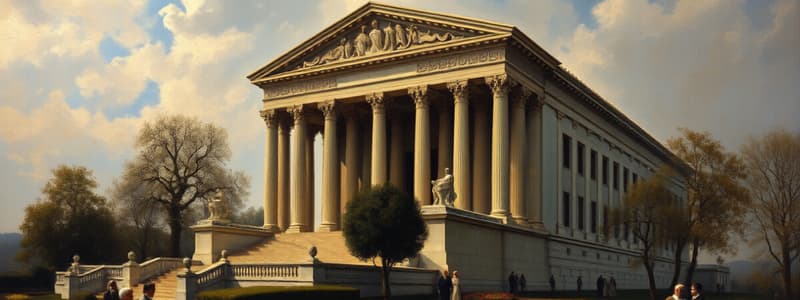Podcast
Questions and Answers
What is Dual Federalism?
What is Dual Federalism?
- A system with no federal oversight.
- A system that promotes states' rights.
- A system where national and state governments are seen as separate entities. (correct)
- A system where national and state governments work together.
What is an example of what dual federalism looks like?
What is an example of what dual federalism looks like?
Congress's commerce clause powers.
What is another name for dual federalism?
What is another name for dual federalism?
- Marble cake
- Pudding
- Cake batter
- Layer cake (correct)
What was the significance of Chrisholm v. Georgia?
What was the significance of Chrisholm v. Georgia?
What did McCulloch v. Maryland uphold?
What did McCulloch v. Maryland uphold?
What was the ruling of Dred Scott v. Sandford?
What was the ruling of Dred Scott v. Sandford?
What did the National Labor Relations Board v. Jones & Laughlin Steel Corporation rule?
What did the National Labor Relations Board v. Jones & Laughlin Steel Corporation rule?
What is Cooperative Federalism often described as?
What is Cooperative Federalism often described as?
Name an example of Cooperative Federalism.
Name an example of Cooperative Federalism.
What characterized the Era of Cooperative Federalism?
What characterized the Era of Cooperative Federalism?
What is New Federalism?
What is New Federalism?
When did New Federalism begin and through which presidencies?
When did New Federalism begin and through which presidencies?
What is Coercive Federalism?
What is Coercive Federalism?
When did Coercive Federalism occur?
When did Coercive Federalism occur?
Give an example of Coercive Federalism.
Give an example of Coercive Federalism.
What does 'Picket fence federalism' refer to?
What does 'Picket fence federalism' refer to?
What is Fiscal Federalism?
What is Fiscal Federalism?
What are the three types of grants?
What are the three types of grants?
What are Categorical grants?
What are Categorical grants?
Give an example of Categorical grants.
Give an example of Categorical grants.
What are Block grants?
What are Block grants?
What was general revenue sharing (GRS)?
What was general revenue sharing (GRS)?
Why did conservatives and liberals oppose GRS?
Why did conservatives and liberals oppose GRS?
What are Unfunded mandates?
What are Unfunded mandates?
What reinforced the role of the national government?
What reinforced the role of the national government?
What are Federal preemptions?
What are Federal preemptions?
What is federal preemption based upon?
What is federal preemption based upon?
What is Competitive Federalism?
What is Competitive Federalism?
How is Competitive Federalism a check on tyranny?
How is Competitive Federalism a check on tyranny?
Why can competition between states be seen as a bad thing?
Why can competition between states be seen as a bad thing?
What are Project Grants?
What are Project Grants?
Flashcards are hidden until you start studying
Study Notes
Types of Federalism
- Dual Federalism (1789 - 1933): Characterized by a clear separation between national and state governments, limiting federal powers to those explicitly enumerated in the Constitution.
- Layer Cake Metaphor: Dual federalism is often likened to a layer cake to illustrate its distinct separation of powers.
- Commerce Clause Power: Congressional authority to regulate interstate commerce exemplifies dual federalism in practice.
Landmark Supreme Court Cases
- Chisholm v. Georgia (1793): Established that citizens could sue other states, leading to the Eleventh Amendment, which prohibits such lawsuits.
- McCulloch v. Maryland (1819): Confirmed Congress's authority to create a national bank and reinforced the principle of national supremacy over state laws.
- Dred Scott v. Sandford (1857): Declared that slaves were property and invalidated the Missouri Compromise, exacerbating tensions that sparked the Civil War.
- National Labor Relations Board v. Jones & Laughlin Steel Corp. (1937): Affirmed the National Labor Relations Act's alignment with the commerce clause, broadening federal regulatory powers.
Evolution of Federalism
- Cooperative Federalism (1933 - 1964): Described by the "marble cake" metaphor, emphasizing collaboration between national and state governments to deliver services.
- Civilian Conservation Corps (CCC): Example of cooperative federalism, showing how federal programs were implemented at the state level during FDR's New Deal.
- New Federalism (1969 - 2001): Aims to transfer power from federal to state governments through block grants, initiated during Nixon's presidency and continued under Reagan and Clinton.
- Welfare Programs: Illustrate the principles of New Federalism with a focus on state-level decision-making flexibility.
Coercive Federalism
- Definition: Federal government exerts pressure on states to modify policies through regulations and funding threats.
- No Child Left Behind: Notable example of coercive federalism, illustrating federal mandates imposed on states.
Contemporary Federalism
- Picket Fence Federalism: Highlights the collaboration among policymakers across different government levels within specific policy areas.
- Balanced Federalism Era: Characterizes the current federalism landscape, combining elements of cooperative federalism, national supremacy, dual federalism, and states' rights.
- Fiscal Federalism: Pertains to financial transfers from the national government to lower levels, influencing state policies.
Grants and Funding
- Three Types of Grants: Includes categorical, block, and general revenue sharing grants which vary in purpose and allocation authority.
- Categorical Grants: Designated for specific purposes, such as a mass transit program.
- Block Grants: Allocate funds to states with discretion on spending within certain policy areas.
- General Revenue Sharing (1970-1980): Provided states with funds to be spent at their discretion, previously a point of contention among conservatives and liberals.
Additional Concepts
- Unfunded Mandates: Federal requirements for states to act without financial support from the federal government.
- Federal Preemptions: National legislation that overrides state law, based on the Supremacy Clause.
- Competitive Federalism: States compete for businesses by developing favorable policies, which can sometimes lead to negative consequences like weakened environmental regulations.
- Project Grants: Funding avenues for local and state governments seeking support for specific initiatives.
Studying That Suits You
Use AI to generate personalized quizzes and flashcards to suit your learning preferences.




